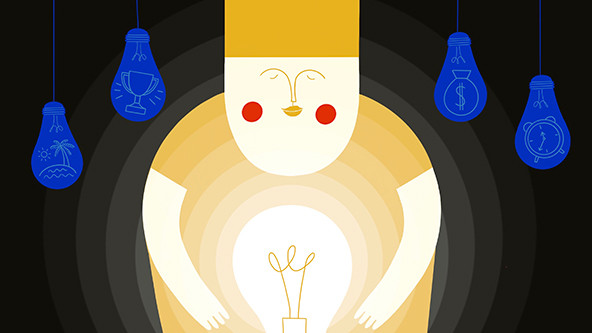 (Illustration by Helena Pallarés)
(Illustration by Helena Pallarés)
Previous stories in this article series, Centered Self, have explored the connection between inner well-being and social change, the different ways people working in social change can engage in a process of self-inquiry, and how funders can support grantees’ well-being. But despite growing recognition that well-being has positive impacts on individuals, organizations, and society, not everyone is on board. Many people continue to view well-being support as a luxury, or at least not a necessity, or as immaterial to creating social change.
I know this because, over the last few years, I’ve tried to put well-being on the agenda of the German social sector and create initiatives that address the well-being needs of our community. Despite having a broad network and deep experience in the field—as the founder of both Germany's largest crowdfunding platform for social projects and a think tank that researches digital technologies for the common good—it’s been difficult. In my many conversations with funders and executives, I’ve met with evasiveness and resistance, and encountered a whole range of critiques related to the legitimacy and effectiveness of a well-being orientation.

Many other pioneers of well-being initiatives have faced the same challenges over the years, but both they and I have also found some successes. In my own work, I’ve learned that helping donors and other potential advocates gain a more authentic and deeper understanding of what well-being is and why it matters can overcome skepticism and ultimately lead to support.
Knowing what and how to share in these conversations is an art in itself. I’ve often found it necessary to not only share the intellectual arguments but also something of myself. At first, opening up felt scary, but over time, I found joy in meeting other people at a much more human level. Of course, many people are unused to personal sharing. Some are bewildered or uneasy by the turn our conversation takes. I’ve learned to adjust my level of openness, sensing what makes the other person comfortable with our exchange. Once we’ve established a more personal connection, we often end up discovering similar experiences and relating to each other in completely new ways.
The exchanges below reflect five of the most common critiques I’ve encountered and how I’ve respectfully engaged with those concerns. While a few of them touch on ideas in previous articles, the aim here is to directly address some of the “elephants in the room.” My hope is that these perspectives can help nonprofit leaders better advocate for well-being practices within their organizations and more successfully engage funders in support.
Inner Well-Being, What? You Mean Spas and Massages?
A wide range of organizations and practices have adopted the term “well-being” in recent years, but in the context of social change, well-being doesn’t mean spa treatments or candles in the bath. Inner well-being, as defined by The Wellbeing Project, refers to a sense of wholeness and connection that entails personal development, healing, and integration of self. Practices that support an individual’s inner well-being can include meditation, spending more time with family, keeping a journal, or working with a therapist. These practices are a means to finding good mental health, more life satisfaction, a greater sense of purpose, and the ability to manage stress.
Achieving well-being often requires commitment and significant effort. While people often perceive me as confident, for example, it belies the fact that I have suffered from hypochondria and other anxieties all my life. Through a regular meditation practice and work with a somatic coach, I’ve learned to put less effort into hiding these “weaknesses,” and become more authentic and at ease in my interactions.
This orientation toward well-being is also part of a larger shift in how we measure human development and progress, from purely economic indicators to more people-centered indicators. In 1990, the United Nations introduced the Human Development Index, which, rather than measuring just economic development, measures the overall development of people through three dimensions: longevity, knowledge, and standard of living. Countries such as Iceland, Scotland, and Finland now officially place mental health above gross domestic product, and design policies and budgets based on well-being priorities. And in 2019, New Zealand created a well-being budget for tackling mental illness, domestic violence, and child poverty.
If You Ask for Help, You Must Be Weak
Recognizing our weaknesses and asking for help takes courage and strength; none of us likes to feel vulnerable. But acknowledging our whole selves, not just the parts we think shine, we are better equipped to connect with others at a human level, which further opens up ways of collaborating and problem-solving.
For many years, I imposed this narrative on myself. It took many years of self-inquiry for me to fully acknowledge vulnerable parts of myself—anxieties, sadness, and feelings of loneliness—and to understand the price I was paying for hiding them. Not speaking up, not sharing what I felt, and trying to show up as a perfect human being when I was struggling inside meant that the life I was living wasn’t grounded in integrity. I learned to confront my “shadows,” but it was an often painful process because it involved coming to terms with and accepting all aspects of myself.
Many participants in The Wellbeing Project found that identifying vulnerabilities and asking for help made them feel more alive and more capable of serving others. This is partly because confronting our own humanity helps us empathize with other people’s struggles—a critical part of stepping down from the pedestal of “the helper” or “the savior” to someone who resonates with and serves others on an equal footing. As one participant said, “[There is a] different quality in my work, in my team, because I make myself more visible and also more vulnerable, so it’s not this superhero ‘I can handle everything.’ I admit that I don’t know or that I need something or that I’m not feeling strong. This gives a different quality in the team. More people show themselves also.”
The People Nonprofits Serve Deserve Priority
In light of massive issues like 2.5 billion people lacking adequate access to sanitation or 37,000 people needing to flee their homes every day due to conflict or persecution, the well-being of people working in social change can seem like something that’s nice to have, but not essential.
It may seem counterintuitive that taking care of ourselves drives us away from working on a cause we are passionate about or a community we serve. But inattentiveness to well-being is taking a serious toll on people who work in social change. Many of them have high intrinsic motivation, but frequently face overwhelming need and inadequate resources. Research shows high rates of burnout, marked by emotional exhaustion or unhealthy coping mechanisms, across the social change field and among caregiving professions.
Most of us working in social change have come across the humans behind these figures. I’ve encountered many. A highly motivated colleague of mine could no longer stand the pressure of her demanding job and had to eventually quit, the CEO of a nonprofit I supported as a board member experienced burnout twice, and I know a number of committed volunteers who spent their lives fighting against social exclusion but who now live in poverty. In the end, it’s not an either-or equation: Both social change workers and the people they serve deserve support.
Well-Being Isn’t Directly Connected to Social Change
There is now research showing that increasing the well-being of people working toward social change can lead to profound and necessary changes to the way social change happens. When people are healthier on the inside, they are more able to trust others and more comfortable taking in new ideas.
The tech-based, social change organizations I’ve run over the past 20 years have faced new complexities in the transition from an industrial age of nation-states to the digital, globalized age we live in now. Centralized hierarchies have given way to decentralized networks; new business models and notions of work have disrupted old value chains; and the concepts of freedom and privacy have been fundamentally re-negotiated. Those of us working on and within these changing systems have needed to develop new inner competencies. As traditional institutions dissolve, so do our markers for security and orientation. Instead, we need to find stability inside ourselves and in our relationships. This means getting to know ourselves better, communicating transparently, and understanding and translating between different perspectives.
Inner well-being is critical to our ability to thrive in a fast-paced world and to weave the kind of complex efforts needed to address the challenges we face.
Well-Being Is About Self-Optimization and Working Even Harder
Over the last few decades, we have seen an enormous commodification of well-being methods. At the same time, many companies and individuals have embraced well-being initiatives as a means of increasing employee satisfaction and productivity. But in some cases, a focus on well-being can seem to distract from external elements, such as pay and equity, that have significant effects on well-being. As a result, some critics believe well-being initiatives “blame” individuals for their own unhappiness and suffering, rather than recognize suffering as a consequence of exploitative socio-economic and political systems.
However, just because some organizations are attempting to use well-being to improve the bottom line doesn’t mean it's not valuable. Indeed, the social sector suffers from chronic underinvestment in capacity building, especially compared to the corporate world. US nonprofits, for example, manage to reinvest only 0.03 percent of their annual expenses into leadership development, while the figure is four times higher at corporations.
In truth, the practice of well-being can shift not only the immediate work environment of an individual or their organization but also the larger reality around it. As such, it’s a fundamental part of addressing the broader systems we live in. As a younger social entrepreneur, I was acutely aware of the power imbalance between funders and grantees. I wouldn’t have dared speak out about the more human needs of my organization—things like better salaries, institutional funding, or professional training. I didn’t want to appear vulnerable or needy. But how were funders to know what my organization needed if I didn’t tell them? When I could finally, authentically share the needs of my organization, things started to change. Funders started to understand these concerns, and I realized that so many times they were simply unaware of my reality.
Sweet Success
I’m happy to say that daring to speak out about these topics—daring to engage both intellectually and personally with potential supporters—is beginning to pay off. After trying for two years, my organization, betterplace lab, recently secured substantial funding for a well-being support program. The funding—from a donor community consisting of a German foundation, health insurance companies, and a US philanthropic organization—will provide an introduction to well-being for social change organizations through a series of workshops and coaching.
This leaves me cautiously optimistic that our field is waking up to the importance of well-being—though widespread change will require patience. It takes time for people to open up to new topics, to trust that they are real and valuable. We need to keep in mind that most social sector systems and institutions don’t currently see well-being as essential to their operation. Institutions often only dare to shift their thinking or create new funding structures when they see other donors follow the same path.
Nevertheless, engaging in conversations about the definition and value of well-being is an important part of pioneering a new, healthier culture in which people and the systems around them thrive. The process may at times seem frustrating, but my hope is that the responses to common critiques above give advocates a worthwhile place to start.
Support SSIR’s coverage of cross-sector solutions to global challenges.
Help us further the reach of innovative ideas. Donate today.
Read more stories by Joana Breidenbach.

